
by editor | Sep 18, 2025 | Adventure Learning, Conservation & Sustainability, Critical Thinking, Data Collection, Environmental Literacy, Experiential Learning, Forest Education, Inquiry, Student research, Sustainability, Teaching Science
Expeditionary Learning: Exploring Healthy Forests
By Val McKern and Greg Goodnight
What is a healthy forest? That is the question that Kettle Falls Elementary School fourth graders have been grappling with all winter. In order to examine this question, fourth grade teachers Sally James, Sydney Potestio and Judy Galli have designed an expedition with carefully scaffolded projects for their students. Through these in-depth, service-learning projects, students have been engaged in reading, writing, math, science, social studies and technology. In Kettle Falls we firmly believe that it takes a village to educate a child and we count on a cross curricular approach of teachers and many experts to make any expedition a success for our students. Our priority is creating engaging expeditions that have rigorous learning for ALL students.
Kettle Falls Elementary: an expeditionary learning school
An expedition is the format Kettle Falls Elementary uses to combine adventure and service with learning state standards. Each expedition has standards strategically embedded in fieldwork. The healthy forest expedition will combine many “I can” learning targets based on state standards, with snowshoeing, animal tracking, trail cameras and forestry. In the end, students will deliver PowerPoint presentations to the North East Washington Forestry Coalition (NEWFC) as an authentic audience for their service learning work product. The expedition will provide an exciting and adventurous outlet for student learning and assessments on rigorous state standards. As an Expeditionary Learning School, Kettle Falls Elementary believes that expeditions are the primary way of organizing curriculum.
The subject matter of a learning expedition is a compelling topic derived from content standards. Expeditions feature linked projects that require students to construct deep understandings and skill and to create products for real audiences. Learning Expeditions support critical literacy, character development, create a sense of adventure, spark curiosity and foster an ethic of service. They allow for and encourage the authentic integration of disciplines. (Expeditionary Learning Schools Core Practice Benchmarks p.8.)
 This learning expedition began as all expeditions begin at Kettle Falls Elementary. The staff went through a careful study of the new Washington State standards and determined the “priority standards” at each grade level. The standards are then written as long-term learning targets. Once these standards were determined, teams researched case studies that could become the focus of the learning expeditions. The life science standards addressed focused on life cycles, animal structures and behaviors, food webs, ecosystems and human impacts as the center of the expedition.
This learning expedition began as all expeditions begin at Kettle Falls Elementary. The staff went through a careful study of the new Washington State standards and determined the “priority standards” at each grade level. The standards are then written as long-term learning targets. Once these standards were determined, teams researched case studies that could become the focus of the learning expeditions. The life science standards addressed focused on life cycles, animal structures and behaviors, food webs, ecosystems and human impacts as the center of the expedition.
Literacy is embedded with in the expedition. Priority learning targets are written based on the standards of reading and writing. Reading comprehension strategies and the traits of writing are the focus of these targets. A content map is designed that assigns long term learning targets to each of three expeditions through out the school year. Each expedition runs for eight to twelve weeks.
Learning targets are at the heart of our work. There is clear criteria for posting and referencing learning targets school-wide. Long- term targets, project targets, and scaffolding steps are organized so that students can track their achievement during the daily debrief. We emphasize “learning together, but assessing independently.” Anchor charts that hold the thinking of the class are posted near the targets. The anchor charts will collect information that makes the learning target clear, whether it is knowledge or meta-cognitive thinking. All students are independently assessed on all learning targets.
Kettle Falls Elementary as a 21st Century School
Expeditionary Learning Schools set an expectation for service and authentic work. Kettle Falls Elementary teachers create expeditions that foster service in authentic ways.
Benchmark 3: B. Authentic Audiences
1. Products often meet an authentic need and have an audience and purpose beyond families or the classroom teacher.
2. Some of the products are particularly motivating because in themselves they are acts of service.
(Expeditionary Learning Schools Core Practice Benchmarks p.13.)
We are a Learn and Serve Grant recipient, which has helped us focus on the service aspect of our expeditions. This grant gave teachers release time to write rigorous expeditions and make the community contacts necessary for authentic service. It also supported the expedition through fieldwork and materials for a new expedition.
We knew that this expedition was an outstanding opportunity to educate our students in sustainable education. It meets many of Jaimie P. Cloud’s EfS Frameworks:
Responsible Local/Global Citizenship — The rights, responsibilities, and actions associated with leadership and participation toward healthy and sustainable communities. Students will know and understand these rights and responsibilities and assume their roles of leadership and participation.
Healthy Commons — That upon which we all depend and for which we are all responsible. Students will be able to recognize and value the vital importance of the Commons in our lives, their communities, and the places in which they live.
Multiple Perspectives — The perspectives, life experiences, and cultures of others, as well as our own. Student will know, understand, value and draw from multiple perspectives to co-create with divers stakeholders shared and evolving visions and actions in the service of a healthy and sustainable future locally and globally.
A Sense of Place — The strong connection to the place in which one lives. Students will recognize and value the interrelation- ships between the social, ecological and architectural history of that place and contribute to its continuous health. (Cloud, p. 172-173.)
The North East Washington Forestry Coalition (NEWFC) agreed to partner with Kettle Falls Elementary School. This expedition reaches each of these components of Cloud’s framework. It is the basis of an expedition with an authentic purpose, service, purposeful fieldwork, multiple perspectives and rigorous content.
 Kettle Falls Elementary Bangs monitoring project
Kettle Falls Elementary Bangs monitoring project
Three KFE classes will be engaged in a hands- on learning experience that includes in-class preparation and learning and fieldwork designed to teach them about the life cycles of natural systems, sustainable resource management, and community collaboration. The project will include wildlife, tree, and plant monitoring within the Bangs Mountain Wildland Urban Interface project on the Colville National Forest, as well as presentations and instruction from school and community experts in the field and in the classroom, including members of the Northeast Washington Forestry Coalition. The students will work with the Coalition to complete a final report in the form of a PowerPoint presentation, documenting their monitoring work and educational experience with photos and written reporting. The final report may be posted on the Coalition’s web site, and a final press release may be prepared for local newspapers to share the outcome of the project with the broader community. Derrick Knowles, Education Outreach, NEWFC.
NEWFC is a local organization that believes in demonstrating the full potential of restoration forestry to enhance healthy forests, public safety, and community economic vitality. Because Kettle Falls is community that relies on the timber industry to survive, we wanted to create an expedition that would have many viewpoints. We felt that NEWFC would have the multiple perspectives within the organization that would make our study to compelling to students and community members, since NEWFC is comprised of members who come from the timber industry to those in Conservation Northwest. Our students are seeing that there is not one “right” answer to their question of “What makes a healthy forest?”
Kettle Falls Elementary fourth grade expedition: the stories tracks tell
Case Study One: Indicator Species of Bangs Mountain
Our Learn and Serve Grant gave a team of six staff members the opportunity to participate in a SEA (Service, Education and Adventure) training this fall. This adventure included learning to track with Tom Murphy of Edmonds Community College and the LEAF (Learn-n-serve Environmental Anthropology Field) school. This so engaged the teachers that we were determined to give our students the same opportunity. Murphy was able to create an alterna- tive winter course that brought 12 college students to Kettle Falls for a week. During that time, the LEAF school taught the students how to recognize tracks and gaits of our local animals. The focus was on five animals: whitetail deer, turkey, snowshoe hare, lynx and coyote. These animals were chosen with help from the Forest Service because of their status as indicator species for the Bang’s Mountain area. Students spent time in the forest that week, learning to track, photograph tracks, and measure tracks. They also learned to set trail cameras along trails in order to capture photos of the elusive animals.
Students from Kettle Falls High School Wildlife class with teacher Jono Esvelt participated in each of these activities sup porting the fourth graders throughout this expedition. They also took on the task of writing “field guides” for the fourth graders to use in their work.
This project focused on the learning targets of
- I can independently sort animals by the structures and behaviors that help them survive in their environment.
- I can independently list 4 parts of an animal and describe how the parts help the animal meet its basic needs.
- I can independently generalize from multiple forms of text to learn about forest animals.
- I can independently elaborate using details and/or examples about one forest animal.
- I can edit for capitals against the class capitalization chart.
Students learned about each animal through predicting structures and behaviors by analyzing a collage of photos and You Tube videos. Predictions were recorded before reading field guides and predictions were confirmed or not. Once the recording sheets were completed, the students wrote expository papers on the survival structures and behaviors of each animal. These were combined to create PowerPoint slides that will be included in their final product, some with actual photos of the tracks or animals that were photographed at the Bangs Mountain site. The good news was that some animals were captured by the trail cams, but some remained elusive!
Case Study Two: Food Webs of Bangs Mountain
This project really focused on the interdependences within the forest ecosystem. Learning targets in this investigation focused on giving students the knowledge to be able to complete the narrative prompt:
You are a wildlife biologist researching animals on Bangs Mountain. One of your jobs is to report to the community of Kettle Falls the stories the animal tracks of an indicator species told you while doing your fieldwork. To do this you will need to describe where the tracks were found and your inferences of what the tracks are telling you about that animal’s daily life:
- I can describe the interdependences in a forest ecosystem.
- I can explain how a forest ecosystem impacts animal population.
- I can independently generalize from multiple forms of text to learn about forest ecosystems.
- I can write a narrative with a clear beginning, two events and a clear ending.
In order to make this narrative realistic students needed to understand the actual role of a wildlife biologist. Learning about careers while in engaging expeditions opens our students’ eyes to the world of possibilities. Students continued their fieldwork, checking their trail cams, snag counts (their first monitoring experience), searching for tracks and other sign of life in their plots and were prepared for snowshoeing (though there simply wasn’t enough snow for them this year). Using the reading skill of “generalizing to understand” helped student comprehend the interdependence of the forest and was built through reading, photography, experts, media, data and many simulation games. After each activity students recorded “new learning” on anchor charts that build the content schema. They also recorded their use of the skill “generalizing” on anchor charts to show their ability to be meta-cognitive about comprehending new material. Students were able to use the information gathered from the multiple sources to write their narrative.
Case Study Three: Bangs Mountain as a Changing Ecosystem
Now that the students have developed a level of knowledge about the interdependence of forests they are ready to move on to the changing ecosystem. This is when they really become experts and begin to look at the many stakeholders of the forest. Their fieldwork becomes very data based. Through skill building in P.E. they learn about pacing. Each child is responsible for pacing off 104 feet, using a compass to keep their lines straight, they determine a half acre plot for their team. They use a tape to measure their accuracy after pacing and the corners are marked on the GPS so that their plot can be found on Google Earth. Students are now collecting data on the canopy by measuring open and covered areas. They have learned to use transect lines during their monitoring. This data is part of the baseline that will be used in the study. They identified three plants in the understory and did a plant count of their plot. Their study of the animals in their plot also continued, with data from tracks and trail cam photos. The most common track and photo taken was squirrels, though they are not one of the indicator species. Students found little evidence of the lynx at their plot. Animal population changes will be one indicator of increased health of the forest over time.
During this project students learned about many changes that can happen to forests over time. The learning targets for this project are:
- I can independently describe how onepopulation may affect other plants and/or animals in the forest ecosystem.
- I can independently evaluate one population in different forests, determine which will thrive and give clear reasons.
- I can independently describe three ways that humans can improve the health of the forest ecosystem.
- I can independently assess the author’s effectiveness for a chosen audience.
- I can independently organize my writing.
This means:
- I will write an introduction, supporting details using examples, and conclusion in an expository writing.
Each day of this project focuses on a change in the forest ecosystem. Some are changes that have taken place at the Bangs Mountain Project and some are changes that could eventually happen. All students receive the same reading each day, but they read the articles for a different purpose: natural or man-made changes, population changes, or gradual or rapid changes. Each student becomes an “expert” on their article. The students then “jigsaw” their articles once they have recorded the important information. The student experts then share out in small groups, creating a real need for students to comprehend and analyze their text. Special Education and Title I students are pre-loaded with vocabulary and content before the article increasing their ability to fully participate while in class. Once the information has been analyzed students come together to complete anchor charts where they record the changes and determine if human impact was positive or negative. They also determine the author’s purpose and if the author was successful in delivering their message.
By the end of this case study they have a thorough understanding of thinning, prescription fires, recreation management, forest flu and other healthy management issues.
We believe that reading is only one vehicle to understanding new ideas. Fieldwork, media and experts are also key components to creating powerful learning tools. Experts from the timber industry, Forest Service, Conservation NorthWest, and Department of Fish and Wildlife have all volunteered to work with our students, ensuring that students are learning realworld applications of the knowledge. Each of these experts will not only share their expertise on managing forests and their per- sonal perspectives of what makes a healthy forest, but also about their careers.
The students will complete this project with a simulation from Project Learning Tree, “The 400 Acre Wood.” Students will determine the actions taken to manage a forest much like their plots on the Bangs Mountain Project. This project has a balance of Vibrant Economy, Healthy Environment, and Equitable Society, as recommended by The Sustainable Design Project Teacher Manual. (Wheeler, Bergsman, Thumlert 2008.)
 The Final Presentation of “What is a Healthy Forest?”
The Final Presentation of “What is a Healthy Forest?”
The final project is a culmination of all of the data that the students have collected while completing this project. Data is compiled in a variety of ways. The ani- mal monitoring is a graph of the sightings caught on the trail cams, the plant monitor- ing is a graph as well, both done on Excel. The canopy is drafted on graph paper, indicating the cover and open space. There is also the map from Google Earth, indicating each plot for future reference and to gauge changes over time. This work is gathered in a Power Point to be presented to NEWFC at a future meeting.
Kettle Falls Elementary: expeditionary learning and 21st century intertwined
Our students had the opportunity to become engaged in their local forest, gathering a respect for the land, observing the interdependence and understanding the decisions made by others that use our forests. Students were able to meet rigorous learning targets and assessed independently on each target. They collaborated to create authentic projects that reach beyond their school walls.
The expedition included many different modes of learning during this project that are key to Heidi Hayes Jacobs’ Tenets for Purposeful Debate leading to Content Upgrades:
- • A personal and local perspective is developed and presented in the content area, where natural and viable.
- • The whole child’s academic, emotional, physical and mental development is thoughtfully considered in content choices.
- • The possibilities for future career and work options are developed with an eye to creative an imaginative directions.
- • The disciplines are viewed dynamically and rigorously as growing and integrat- ing in real-world practice.
- • Technology and media are used to expand possible sources of content so that active as well as static materials are included. (Jacobs p 31).
Through compelling expeditions students at KFES achieve many 21st century outcomes. Students build strong habits of work, through both performance (traits that enable students to perform to their potential) and personal relationships (traits that enable students to be good people and community members). They are motivated to learn. Students believe that they have the ability to meet their targets, have clear targets that they can self-assess their progress against, and are connected to their school through the work they do. We believe that academic achievement is increased when students are engaged in learning. Through authentic expeditions like “The Stories Tracks Tell” students build life and career skills. Real world problems increase students’ critical thinking and problem solving skills. The use of technology opens the classroom to wider world, with meaningful examples of the work our students are doing. Our students increase their understanding of 21st century themes such as environmental literacy. (Hulleman, Hartl & Ciani 2009). Through compelling expeditions our students are engaged, supported and held accountable to high standards.
References
Hulleman, C., Hartl, S., & Ciani, K. (2009). Character, Motivation, and Engagement in Expeditionary Learning Schools, Review of the Relevant Literature and Available Measurement Instruments. Nellie May Education Foundation. Expeditionary Learning Core Practice Benchmarks (2003). Garrison, NY: Expeditionary Learning Outward Bound.
Jacobs, H. H. (2010). Curriculum 21: Essential Education for a Changing World. Alexandria, VA: ASCD.
Wheeler, G., Bergsman, K., and Thumlert, C. (2008). Sustainable Design Project Teacher Manual. Olympia, WA: Office of the Superintendent of Public Instruction.
Greg Goodnight is superintendent at Kettle Falls School District.
Valerie McKern is principal at Kettle Falls Elementary.
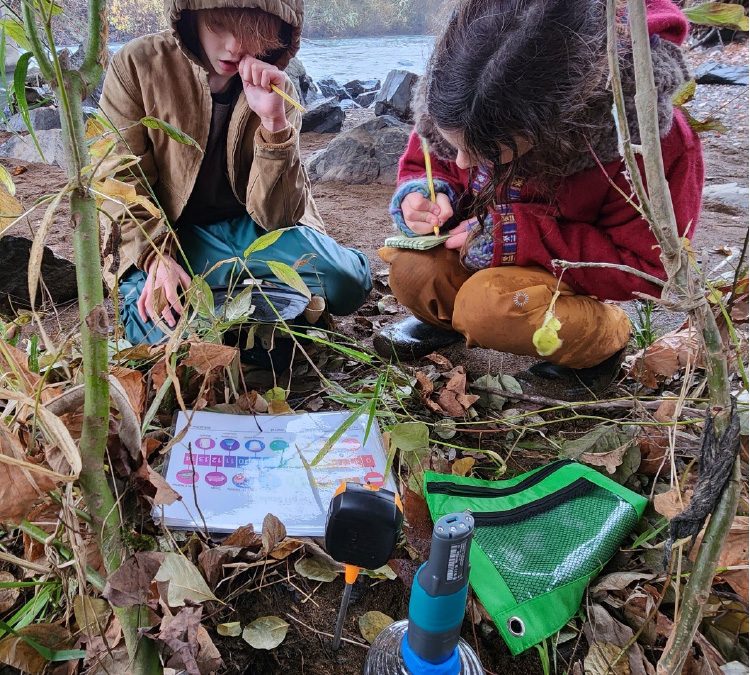
by editor | Sep 15, 2025 | Adventure Learning, Conservation & Sustainability, Critical Thinking, Data Collection, Environmental Literacy, Experiential Learning, Forest Education, Homeschool, Inquiry, Outdoor education and Outdoor School, Place-based Education, Questioning strategies, STEM, Teaching Science
A Natural Fit: Homeschooling and the Establishment of a Research Forest
by Jess Lambright
For those open to an alternative educational path, a classroom with no walls or desks but instead trees, meadows, and streams, offers abundant opportunities for scientific exploration. My journey in outdoor education started by home-educating my own children, but soon expanded to include other students and families. Although making everyday a field day comes with certain challenges—such as very wet, cold winter days—it has also shown me how adaptable young people are, and how many spontaneous and fascinating learning opportunities present themselves when you commit to regular immersion in the natural world.
I have come to appreciate the vast range of possibilities in which students can acquire knowledge. While some homeschooling families follow packaged curriculum closely and monitor carefully to make sure their children meet state standards each year, others chose a less structured approach called unschooling, rooted in a deep trust for kids’ natural tendency and ability to learn. This philosophy can free a motivated young person to dive deeply into an ocean of learning powered by autonomy, inspiration, and infinite possibilities.
Connecting to place and stewardship of land
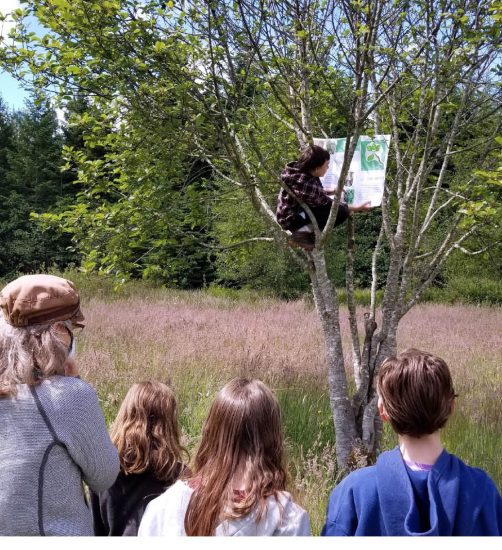
A multi-disciplinary unit study called My Tree and Me, where each student was connected with a specific tree which they measured (diameter, height, age) conducted secondary research about the species, wrote poetry, and created art with materials from the tree. One student decided to give his final poster presentation from the branches of the Cascara tree he had spent so many hours with.
The first outdoor program I hosted involved an established group of kids spending an entire day outdoors, once per week, for over four years. Week after week and year after year we returned to the same 40-acre woods from the first days of fall through the start of summer. It was common for our group to wander through the forest, without a destination or agenda, letting our innate curiosity lead the way. Wandering freely, with open eyes, allowed us to get in touch with what excited us and created opportunities for true discovery (Young et al., 2010, 56).
It filled me with satisfaction to watch the deep connection to place that developed over time in each of us. Monuments and landmarks, like a circle of giant old moss-covered stumps towards the southwest corner of the forest, acquired names and memories and provided comfort and familiarity when they were encountered. We would experience the wet meadow as a place that requires rubber boots to traverse in the wet months, a beautiful explosion of white flowers and soft grasses that dance in the wind in the summer, and a sea of delicate purple camas flowers in the spring. One year we returned to the same sit spots week after week, recording changes in our journals as spring brought all the growing things to life.
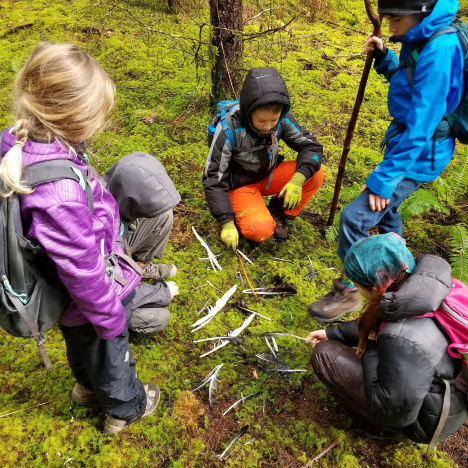
Students pause to examine a pile of feathers they discovered while exploring the woods on a rainy day. The group came up with a series of questions about what happened and brainstormed ideas about how they could investigate further to potentially find answers.
Spending time on a particular piece of land, through the seasons and years, inevitably leads to a sense of kinship and creates an urge to protect and enhance the natural environment. It’s been rewarding to teach students about which plants are non-native and potentially harmful to the local ecosystem, then see them step up as guardians of the land. When we wander through the woods, sometimes they spot a pocket of invasives and if we’re lucky enough to be carrying long-handled loppers, the team of weed warriors can quickly level a patch of Himalayan blackberry. In addition to studying and exploring, offering students an opportunity to actively participate in land management elevates their sense of purpose and deepens their connection to the natural world.
Full Family Learning
Homeschooling naturally leads to multiple ages and families all learning together. In the early days of our homeschool outdoor program the adults often observed activities and supported logistics. But over time it became clear that we truly were a mixed-age group of learners and explorers. Treating everyone as learners equally can have the effect of empowering young people. Sometimes kids master skills quickly. teaching what they’ve learned to adults. And sometimes the best exchange comes not from experts, who have a deep and longstanding understanding of a concept- but those who have recently experienced the gift of insight.
Mixed age learning is a mutually beneficial relationship fostering growth in multiple ways. Adults sometimes shelter in the security of topics they already understand and avoid venturing into areas less familiar. Conducting scientific inquiry in nature is ideal for having a high ceiling and a low floor: everyone knows something, and no one knows everything! Cultivating a growth mindset, by creating an atmosphere where mistakes are celebrated as learning opportunities, and where having a question is as valuable as having an answer (Boaler, 2015, 11), pairs beautifully with immersive study in nature.
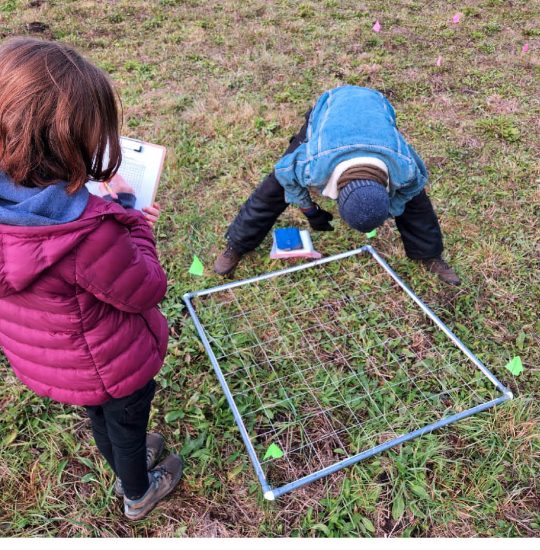
A team of researchers determine the percent meadow knapweed present in a one-meter plot square by examining each of 100 smaller squares for the plant of interest.
Authentic Curriculum
Each day that I meet a group of students in the natural world, I come prepared with a plan for that day. Sometimes my plans are elaborate and detailed, and sometimes they are less specific and open to input from my fellow adventurers. But without exception I am mentally prepared and openly delighted to be upstaged by the unexpected. Whether it is locating a dead porcupine after noticing an unusual smell, being suddenly pelted by large hail, being startled by the arrival of the cacophonous noise of a murder of crows, or being circled by two deer so distracted in their mating dance that they fail to notice us; being fully present for nature’s dramas is my top priority.
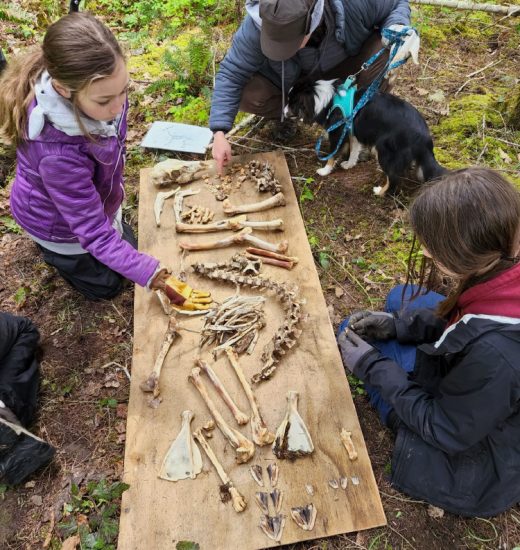
After waiting over a year for the soft tissue to decompose, students collect and sort bones from a deer that died of natural causes near the Bear Creek Wilderness.
One day, just as the families were arriving at the Bear Creek Wilderness, a truck with two wildlife professionals pulled up to examine a deer laying in the horse pasture adjacent to our meadow. Curious, we gathered to ask questions about what might have happened. When they offered to let us keep the recently deceased animal, we gladly accepted- and spent the day dragging it across the meadow into the woods, securing it with paracord, and setting up our two trail cameras to watch what would happen.
Each week we checked on the deer, and everyone brave enough to venture near got to experience first-hand what decomposition looks and smells like. The camera footage revealed a series of fascinating dramas involving a bobcat, opossums, neighborhood dogs, and finally turkey vultures. A year and half later we carefully collected the bones and spent hours sorting and reconstructing a full deer skeleton. Finally, we tried our hands at making bone tools. In my experience, the best learning opportunities are not planned or expected. But when we build regular rhythms and practices, it is possible to “lay the groundwork for the outbreak of authentic curriculum” (Sobel, 2008, 81).
Cultivating scientific inquiry

Students work to match specific leaves to nature journal pages. Each student found a leaf while wandering through the woods, then recorded details of that leaf in their nature journals using words, pictures and numbers. The leaves were collected, then each student selected a new leaf and found the corresponding journal page.
Getting to know a place, including its seasonal changes, provides a useful perspective when it comes to asking research questions. An invaluable tool to record and remember discoveries, questions and observations is the field notebook, or nature journal. Developing the habit of collecting data with pencil and paper while exploring the natural world takes ongoing dedication, is deeply personal, and will certainly evolve through the years if one continues the practice (Canfield, 2011, 187-200). Nature journaling techniques that involve close examination of specimens in order to draw them, often reveal details that would have been overlooked with a quick glace or photograph. Indeed, to truly get to know a specific plant species it is hard to imagine an activity more educational than carefully drawing each of its parts.
Foundational to scientific inquiry is the research question, or asking questions within the realm of science. There are plenty of valid and interesting questions that one might ask while pondering the wonders of nature, and it’s important not to shut down inquiry when a question like, “Does it make this tree happy when I climb it?” arise. If limited to knowledge bound by science, one may miss rich worlds of philosophy, spirituality, intuition, and other ways of knowing. Still, once we are ready plot our scientific course it’s useful to remind students that questions should be measurable (Laws & Lygren, 2020, 90-93).

At the start of a student-led wildlife study, one researcher, who had taken time to carefully read the manual and test out the equipment, teaches the other students how to label their memory cards and set up their trail cameras. This project was made possible by a generous grant from the Diack Ecology Education Program.
Research Methods
When guiding young people into the world of field research it is helpful to start with basic techniques and big picture, cross-cutting concepts. Keeping track of important details in a field notebook and not forgetting to record obvious but key information like the date and location takes practice before it becomes routine. Collecting data can be time consuming, but sometimes trying to interpret sloppily recorded field notes can lead to tedious and frustrating hours at home. Finding a doable and interesting research question, taking into account confounding factors, and dealing with the disappointment if all the hard work to apply different treatments on an invasive plant all result in similar outcomes, requires a certain level of maturity and commitment.
Digging into a full-fledged research project requires determination, perseverance, and time, but it is possible to introduce students to the exciting and fun parts without getting bogged down by details. I recently taught a research methods class to elementary and middle school students with the goal of having hands-on experience with sophisticated research equipment without requiring data analysis or report writing.
We practiced collecting samples, and at first, we recorded in our field notebooks all the important metadata. Inspired by collection and observation, but limited in time, we then simplified the process to maintain interest and focus. For the rest of our forest walk we collected whatever samples caught our eyes- and mentioned what we would record if we were doing a research project- but kept it fun and quick so we still had time to investigate them at the end with magnification. Keeping data collection fun and exciting for younger students makes for a useful introduction to scientific inquiry and sets them up for conducting their own research in the future.
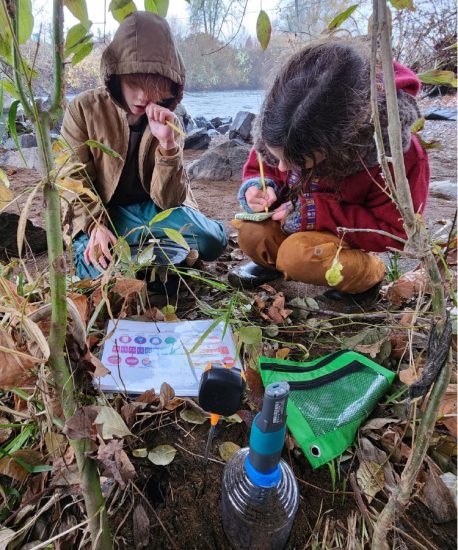
Students collect carbon dioxide and pH data from a patch of earth using equipment funded by the Diack Ecology Education Program during a research methods class with Wild Alive Outside.
Student-Led Research
In my experience, homeschoolers have a low tolerance for contrived activities, busywork and doing things for a grade. Any activity, assignment or project needs to be authentically meaningful. While it may be hard to force them to fill out a worksheet recording what we just discussed, they often thrive with open-ended activities and projects they can direct. It’s important to provide the appropriate scaffolding, and offer examples, but I have been impressed by how quickly and enthusiastically students construct their own research projects. As a mentor, I sometimes struggle with finding balance between requiring them to do something ‘right’ and encouraging critical thinking along with a safe place to fail, each of which are valuable learning experiences. Allowing students to take ownership in the learning process enhances the development of scientific thinking.
Once, a student created an elaborate plan to attract birds for his trail camera research project involving dead trees, peanut butter, and bird seed. There was tangible disappointment when the resulting images revealed many more rodents than birds, but it led to a new series of questions as well as an understanding about wildlife activity in that area. Field science is almost always iterative in nature, with new questions emerging from initial data and, ideally, the opportunity to inquire further and collect more data. With guidance and partnership students integrate information while maintaining natural curiosity.
Expanded Educational Support
Last year our outdoor program, Wild Alive Outside, received its first infusion of grant-funded scientific equipment. The Diack Ecology Education Program financed a set a trail cameras for our students to study wildlife activity at the Bear Creek Wilderness. Access to high-quality equipment has been a game changer for our little research group. Students felt empowered to design their own experiments by having full control over one of the trail cameras and two high-capacity memory cards. In addition to learning what wildlife passed through the area of the forest or meadow they selected, they gained experience with organizing and analyzing digital data. For some, it was their first exposure to spreadsheets, and others had to push their edges to patiently examine each of hundreds of photos. After months of data collection and conducting secondary research on one of the many wildlife species they discovered, they created posters to present their findings.
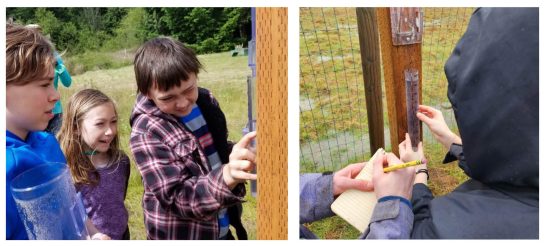
Students carefully measure the water in the rain gauge to determine rainfall over the previous week. Data is later reported to the CoCoRaHS website as part of a nationwide citizen science initiative.
For several years now, each day on the land begins with checking the rain gauge. Because we only visit once per week, we often have several inches of rain to carefully measure and record in the notebook. This simple ritual wakes up scientific thinking: “remember to look straight on before taking a reading,” connects us to what’s been happening while we were away: “no wonder there’s standing water in the meadow,” and gives us access to site-specific long-term data. At the end of the water year, shortly after the start of autumn, we can look back at the data we’ve collected, compare it to previous years, and make predictions for when the rains might come that fall. Additionally, we report our data through a sophisticated citizen science program called CoCoRaHS – Community Collaborative Rain, Hail & Snow Network with thousands of other citizen scientists across the country. I have found students take data collection quite seriously when they know they are part of a larger community of scientists, all doing their best to produce accurate results.
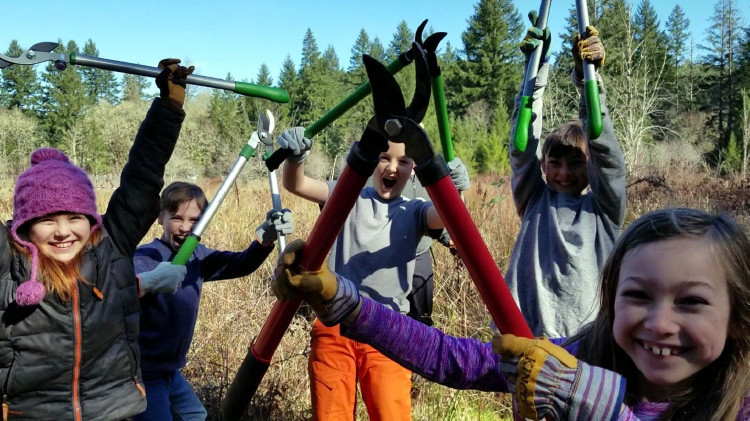
After tackling a large patch of invasive blackberry bushes, the Weed Warriors celebrate their contribution to protecting the wet meadow in the Bear Creek Wilderness.
The Bear Creek Wilderness and Student Research Forest
My program design is to plant the seeds for creating a student research forest where young people will have ongoing opportunities to learn scientific methods of field research and contribute to an ever-increasing body of knowledge through their own efforts. Just as the H.J. Andrews Experimental Forest welcomes graduate students and long-term ecological researchers and has amassed a wealth of knowledge and data about that site, we aim to support young emerging scientists with open minds and creative ideas to connect with place, nature, and make meaningful contributions to science within a community of knowledge seekers. Participants gain foundational skills together as they engage with the land, utilize scientific tools, grow as learners, and share knowledge with each other.
References
Boaler, J. (2015). Mathematical Mindsets: Unleashing Students’ Potential Through Creative Math, Inspiring Messages and Innovative Teaching. Wiley.
Canfield, M. R. (Ed.). (2011). Field Notes on Science and Nature. Harvard University Press.
CoCoRaHS – Community Collaborative Rain, Hail & Snow Network. Retrieved January 18, 2024, from https://www.cocorahs.org/
Diack Ecology Retrieved January 26, 2024, from https://www.diackecology.org/
H.J. Andrews Experimental Forest. Retrieved January 26, 2024, from https://andrewsforest.oregonstate.edu/
Laws, J. M., & Lygren, E. (2020). How to Teach Nature Journaling: Curiosity, Wonder, Attention. Heyday.
Sobel, D. (2008). Childhood and Nature: Design Principles for Educators. Stenhouse Publishers.

In 2019, Jess Lambright started a nature school for homeschool families where once per week kids and parents spend all day outside learning wilderness skills, exploring, developing naturalist knowledge, conducting field studies, and connecting with nature, themselves, and each other. She founded Wild Alive Outside in the summer of 2023 with the goal of getting more youth outdoors to discover wonder and inspiration in the natural world through science, outdoor skills, and wilderness connection.

by editor | Sep 7, 2025 | Adventure Learning, At-risk Youth, Equity and Inclusion, Outdoor education and Outdoor School, Place-based Education
Children’s Grand Adventure:
The power of potential through the power of place
by Sami Wolniakowski
Southern Oregon University Graduate Student
In order to heal from hardship, for centuries people resorted to nature. The calm and beauty found in the outdoors instills an everlasting joy. In the pristine wilderness of the Jackson Hole Valley, a non-profit organization called Children’s Grand Adventure (CGA) takes this practice and adds another key component called Place-Based Education through their cooperation with Teton Science School. The model that CGA has developed is an innovative program that other organizations would benefit from. CGA is also looking for new partnerships that have a similar mission.
 CGA gives cancer survivors the opportunity to experience the beauty of life within Grand Teton and Yellowstone National Parks. Over the course of a week, students experience America’s first national park in this grand adventure. Chaperones who participated as students in years past accompany current students, giving them role models to help support their healing process. A typical group consists of four chaperones, nine students and three instructors. This offers the ability to build a tight knit community. Emma Hereford is a chaperone who has been a mentor for 5 years. Emma stated:
CGA gives cancer survivors the opportunity to experience the beauty of life within Grand Teton and Yellowstone National Parks. Over the course of a week, students experience America’s first national park in this grand adventure. Chaperones who participated as students in years past accompany current students, giving them role models to help support their healing process. A typical group consists of four chaperones, nine students and three instructors. This offers the ability to build a tight knit community. Emma Hereford is a chaperone who has been a mentor for 5 years. Emma stated:
For months, years, or maybe even a lifetime patients’ lives have been defined by frequent hospital visits, the grueling demands of treatments, pain, psychological damage, and lack of school. Due to these unfortunate circumstances each child’s view on the outside world is nothing but a small glimpse to what it actually is or what it has to offer. For the first time in years, or in some cases ever, survivors finally get to experience travel, environmental education, and develop lifelong friendships for an entire week in one of the most beautiful places in the world.
CGA was started by Stacey C. Kayem in 2008. She believes that, “The more novel the environment, the more students realize within themselves their own nature and capacity to conquer.” In Grand Teton and Yellowstone National Parks students get to hike in Teton Mountains, kayak in glacial lakes, watch apex predators in the wild, and view thermal features in Yellowstone. Every day students are challenged both physically and mentally in a way they never have been before. Stacey states that CGA gives students “the opportunity . . . to join hands with the nature that nearly took them” so that they can “walk forward together into boundless horizons of strength and confident human prosperity.”
 Teton Science School provides field instructors to CGA who are experts of the Greater Yellowstone Ecosystem (GYE). Instructors get to use a Place-Based Education approach to teach students about all that the GYE has to offer. Place Based Education, a pedagogy that uses the power of place to teach students an approach that is learner centered, incorporates design thinking, is interdisciplinary, and uses the community as the classroom. The vice president of field education, Joe Petrick, states:
Teton Science School provides field instructors to CGA who are experts of the Greater Yellowstone Ecosystem (GYE). Instructors get to use a Place-Based Education approach to teach students about all that the GYE has to offer. Place Based Education, a pedagogy that uses the power of place to teach students an approach that is learner centered, incorporates design thinking, is interdisciplinary, and uses the community as the classroom. The vice president of field education, Joe Petrick, states:
During CGA young people benefit from immersion in nature, connections to peers and a sense of empowerment and self-reliance. All of these outcomes are achieved through Place-Based Education (PBE), an approach to education that empowers the learner to explore their world, understand their world and change their world for the better. CGA uses PBE to build an intentional community of leaders who are empowered to harness community resources to support themselves and others.
CGA gives students the ability to come together and make each other stronger, in a bond that will last a lifetime. Stacey Kayem recently recalled the story of a student who was bound to leg braces because his muscles were atrophied. His braces, for the first time, were taken off three months before the program. Unsure and questioning his confidence on day one, he faced the challenge and proceeded to lead the hike for seven days. The pure freedom found in the power of his untapped physical strength was simply waiting to be freed. This student motivated everyone in their field group to persevere through hardships, just by taking one step at a time.
In the future CGA is looking to expand to more hospitals, and use new locations to teach place-based education. Currently, CGA partners with Texas Children’s Hospital, but wishes to establish more partnerships. After reaching over 100 students since 2008, they want to continue the legacy of offering opportunities for students to seek their untapped potential, through the power of place.
 Samantha Wolniakowski recently completed her Masters Degree at Southern Oregon University, where she was a graduate assistant in the MS Environmental Education program.
Samantha Wolniakowski recently completed her Masters Degree at Southern Oregon University, where she was a graduate assistant in the MS Environmental Education program.
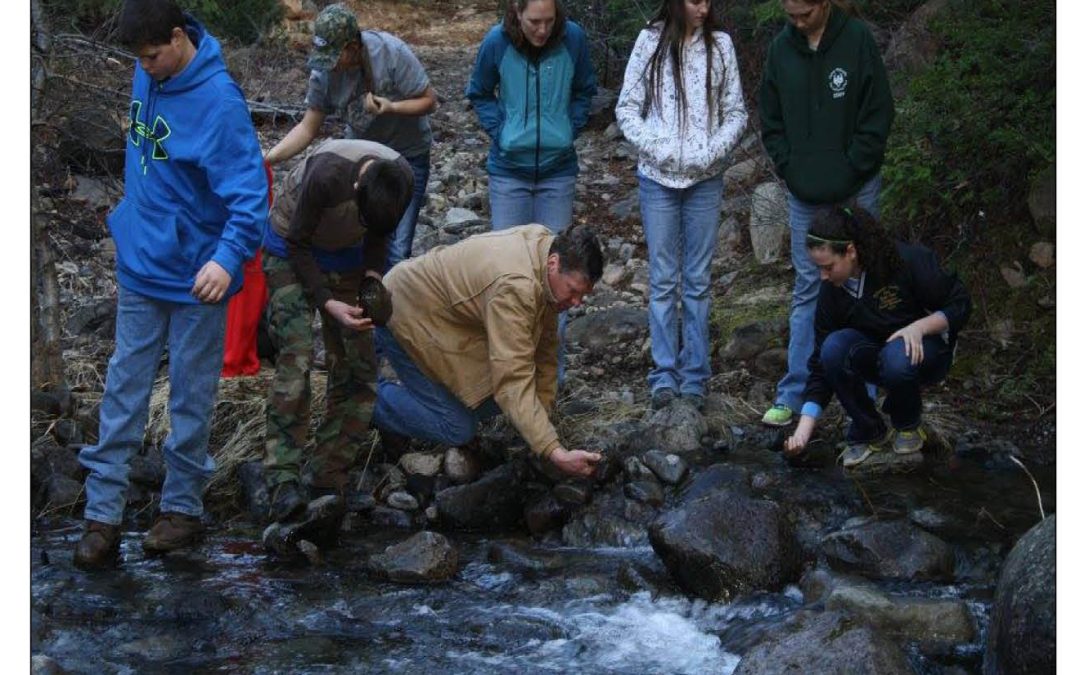
by editor | Sep 7, 2025 | Adventure Learning, Environmental Literacy, Experiential Learning
Discovering Careers in Natural Resources through Outdoor Adventures
by Emily J. Anderson
Oregon State University
Career education and opportunities to explore diverse options in higher education are often limited for many high school students. New college students cite personal interests and work-relevant experiences as the primary factors influencing their degree and career choice (Lent et al., 2002) and perceive a significant lack of career guidance in the secondary school system (Hurley & Thorp, 2002). Traditional and non-formal educators should find new and creative ways to introduce youth to a variety of career options so they can make better informed decisions about their future. Oregon 4-H Explorers provides an example of introducing teens to natural resource career fields through outdoor adventure programming.
In recent decades, American teenagers have shown decreased interest in natural resource professions despite their strong interest in environmental issues (Strandbu & Krange, 2003). Declining enrollments in these degree programs impacts the outlook of natural resource industries. This poses a significant problem with economic success in communities of the Pacific Northwest that are strongly linked to natural resources. Furthermore, a personal connection to nature is a strong indicator of positive environmental ethics and desire to participate in conservation activities as an adult (Guiney & Oberhauser, 2010). For these reasons, one of our educational priorities should be finding ways for youth to value and connect with the resources, potentially leading to the decision to pursue a career in the field.
A young person’s choice to pursue a career in natural resources often stems from exposure to nature at an early age and an attraction to working outdoors (Sharik & Frisk, 2010). Additionally, youth who have a make the acquaintance of a professional in the field are more likely to choose a similar career path (Searle & Bryant, 2009). One study found that the declining selection of natural resource careers is caused by a lack of understanding of what exactly these jobs involve and absence of exposure to the field (Hager, Straka, & Irwin, 2007).
Perhaps the best way to attract youth to natural resource careers is through time spent in the outdoors, developing that all-important connection to nature while interacting directly with those who work in the field. Oregon 4-H Explorers was designed to do just that: introduce teens to careers while participating in an outdoor adventure program with industry professionals.
The benefits of learning in outdoor environments are abundant. Through intentionally designed outdoor experiences, youth advance their knowledge and understanding, attitudes and feelings, values and beliefs, activities or behaviors, and personal and social development (Dillon, et.al. 2005). More specifically, positive youth development programs with wilderness adventure elements can play a key role in addressing the needs of underserved youth (Norton & Watt, 2013). With this understanding, outdoor adventure opportunities are an easy choice for educators introducing youth to careers in natural resources while remaining rooted in positive youth development theory.
Oregon 4-H Explorers is a place-based, experiential education program for 12-18 year old youth. The program spans five months with full day excursions scheduled every-other Saturday and resource material to review in between. Marketing efforts highlight the outdoor adventure and recreation opportunities. However, in addition to technical skill building and nature-discovery, youth are exposed to a new natural resource profession during each excursion. Local professionals participate in each excursion while informally presenting about opportunities to work in their field, which compliments the outdoor activity. For example, a fish biologist joined the Explorers’ rafting trip and talked to the participants about the time he gets to spend on the river for field work. Similarly, a forester led participants on a Pacific Crest Trail hike, a geologist joined the caving expedition, and a climatologist took them snowshoeing at Crater Lake National Park. Inviting these guest professionals on the excursions provides a comfortable, informal way for youth to learn about natural resource topics and a “day in the life” of a professional in the respective field.
Participant evaluation results determined that program goals were achieved. Participants reported a stronger desire to study natural resources in college and pursue a career in a natural resource field. Conjointly, participants have a stronger connection with the natural environment, feel safer and more comfortable outdoors, enjoy outdoor recreation more, care more about the health of the environment and have a better understanding of how ecosystems function.
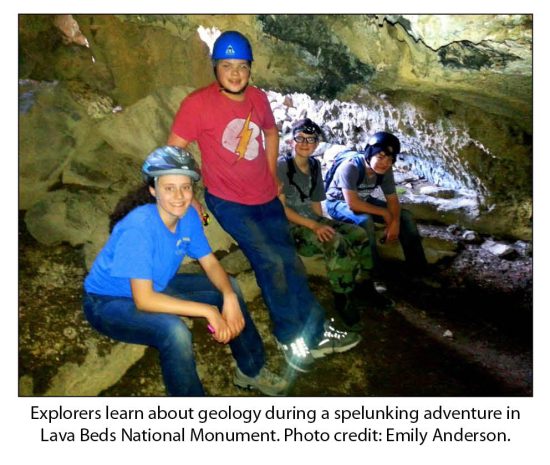 While exploring the great outdoors and natural resource career fields, Oregon 4-H Explorers simultaneously developed valuable soft skills that will provide lifelong benefits in whatever career path they ultimately choose to pursue. Participants reported a stronger sense of independence, increased confidence, and a more positive self-image. Furthermore, upon completion of the program all participants said they were passionate about the topics presented and many believed they would not have had the opportunity to learn about these topics if not for the program.
While exploring the great outdoors and natural resource career fields, Oregon 4-H Explorers simultaneously developed valuable soft skills that will provide lifelong benefits in whatever career path they ultimately choose to pursue. Participants reported a stronger sense of independence, increased confidence, and a more positive self-image. Furthermore, upon completion of the program all participants said they were passionate about the topics presented and many believed they would not have had the opportunity to learn about these topics if not for the program.
All of the youth who completed the inaugural season of Oregon 4-H Explorers wanted to participate the following year. A leadership track was developed to offer the returning participants an elevated experience where they could explore careers more deeply and strengthen their leadership skills. These experienced youth earned the title “Guide” when they committed to the second season of the program. They were tasked with deciding which recreation activities and natural resource fields would be explored in the second season. They were then given the responsibility of leading “tailgate sessions,” or safety talks, and physically guiding the group through adventure activities. They each received 4-H Junior Leader Training, CPR and First Aid certification, Leave No Trace training, and were offered job shadowing opportunities with one of the guest professionals.
The keys to success for Oregon 4-H Explorers that should be considered when designing similar adventure- or nature- based programs are, (1) informal learning and self-discovery, (2) diligent risk management protocols, and (3) strong relationships between youth and adults. Oregon 4-H Explorers follows a true “learn-by-doing,” experiential approach. Activities were intentionally designed to be hands-on and learning was often self-paced. Rather than scheduled lessons or prescribed curriculum, youth learned about natural resource careers through informal question and answer and one-on-one conversation. Risk management and safety are also significant factors in creating an environment where youth are comfortable. In addition to important safety protocols and requirements mandated by the organization, Oregon 4-H Explorers utilized “tailgate sessions” at the beginning of each excursion to discuss safety concerns and precautions for the particular day’s activities. Finally, youth developed strong relationships with the adult chaperones who supervised each excursion. This allowed a deeper sense of safety and comfort while experiencing new, and often risky, activities. The amount of time spent with the guest professionals, typically 6-8 hours, also offered the unique opportunity to develop a comfort level that is difficult to create in an alternative classroom presentation. Youth were able to ask questions about their career throughout the day as the level of comfort increased.
Careers in natural resource fields are alluring options for youth who have a personal connection to nature or would enjoy working outdoors. Unfortunately, many youth do not consider these fields because they are not exposed to them or offered opportunities to spend unstructured time in nature. Non-formal educators are in a prime position to design programs that compensate for these missed opportunities and help youth discover the benefits and rewards of natural resource careers. A tremendous opportunity exists in collaboration between schools and non-formal environmental education organizations.
Non-formal education providers can be excellent resources for school administrators and teachers. Organizations like 4-H Youth Development have the expertise and flexibility to offer out-of-school educational opportunities. Experiential and place-based education outside the classroom is an outstanding way to supplement the traditional classroom experience. Programs like Oregon 4-H Explorers can be developed in collaboration with a class or school to compliment the classroom experience or can be stand-alone educational experiences in out-of-school settings.
Offering opportunities for youth to develop personal connections with nature may be the first step in their eventual selection of a career in natural resources. Oregon 4-H Explorers demonstrates that during or after that connection has been made, creating environments for youth to spend unstructured time with professionals in these fields can have a significant impact on their ability to visualize themselves in those professional roles. Facilitating these opportunities in a way that is fun and engaging for participants has a strong and long lasting impact.
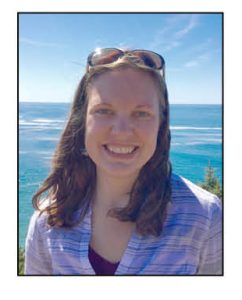 Emily Anderson works for Oregon State University as a 4-H Youth Development Program Coordinator in Lane County, Oregon.
Emily Anderson works for Oregon State University as a 4-H Youth Development Program Coordinator in Lane County, Oregon.
References
Dillon, J., Morris, M., O’Donnell, L., Reid, A., Rickinson, M., & Scott, W. (2005). Engaging and learning with the outdoors – the final report of the outdoor classroom in a rural context action research project. Berkshire: National Foundation for Education Research.
Guiney, M.S. & Oberhauser, K.S. (2010). Conservation volunteers’ connection to nature. Ecopsychology, 1(4), 187-197.
Hager, S., Straka, T., & Irwin, H. (2007). What do teenagers think of environmental issues and natural resources management careers?. Journal of Forestry, 105(2), 95-98.
Hurley, D. & Thorp, J. (2002). Decisions without direction: career guidance and decision-making among American youth. Research report prepared for the Career Institute for Education and Workforce Development. Washington, DC: National Association of Manufacturers.
Lent, R.W., Brown, S.D., Talleyrand, R., McPartland, E.B., Davis, T., Chopra, S.B., Alexander, M.S., Suthakaran, V., & Chai, C. (2001). Career choice barriers, supports, and coping strategies: college students’ experiences. Journal of Vocational Behavior, (60(1), 61-72.
Norton, L.N., & Watt, T.T. (2014). Exploring the impact of a wilderness-based positive youth development program for urban youth. Journal of Experiential Education, 34(4), 335-350.
Searle, S. & Bryant, C. (2009). Why students choose to study for a forestry degree and implications for the forestry profession. Australian Forestry, 72(2), 71-79.
Sharik, T.L. & Frisk, S.L. (2010). Student perspectives on enrolling in undergraduate forestry degree programs in the United States. Natural Sciences Education, 40(1), 160-166.
Strandbu, A. & Krange, O. (2003). Youth and the environmental movement – symbolic inclusions and exclusions. The Sociological Review, 51(2), 177-198.

 This learning expedition began as all expeditions begin at Kettle Falls Elementary. The staff went through a careful study of the new Washington State standards and determined the “priority standards” at each grade level. The standards are then written as long-term learning targets. Once these standards were determined, teams researched case studies that could become the focus of the learning expeditions. The life science standards addressed focused on life cycles, animal structures and behaviors, food webs, ecosystems and human impacts as the center of the expedition.
This learning expedition began as all expeditions begin at Kettle Falls Elementary. The staff went through a careful study of the new Washington State standards and determined the “priority standards” at each grade level. The standards are then written as long-term learning targets. Once these standards were determined, teams researched case studies that could become the focus of the learning expeditions. The life science standards addressed focused on life cycles, animal structures and behaviors, food webs, ecosystems and human impacts as the center of the expedition. Kettle Falls Elementary Bangs monitoring project
Kettle Falls Elementary Bangs monitoring project The Final Presentation of “What is a Healthy Forest?”
The Final Presentation of “What is a Healthy Forest?”

















